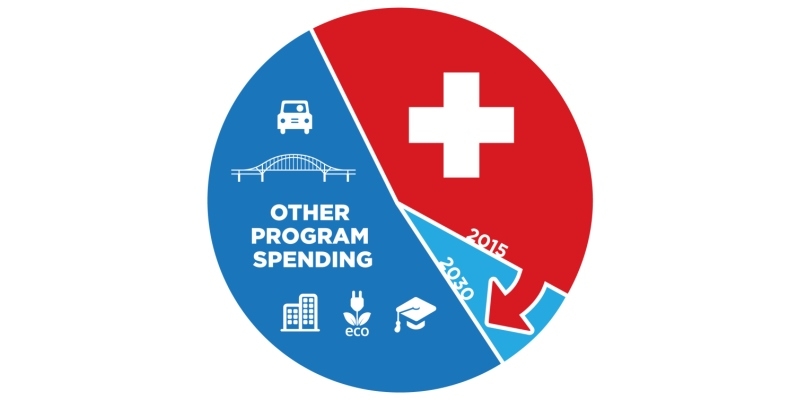The Sustainability of Health Care Spending in Canada

Health care is the single largest budget item for every province in Canada, ranging from 34.5 percent of total program spending in Quebec to 44.6 percent in Nova Scotia in 2015. Any changes in the amount spent on health care can have a significant impact on a government’s fiscal balance (deficits or surpluses), the resources available for other programs such as education and social services, and/or tax competitiveness.
It is therefore vital that we routinely assess historical, current, and expected trends in health care spending in order to determine if such spending is sustainable.
While a number of indicators can help determine the sustainability of changes to health care spending, the most common and informative of these indicators are the share of program spending represented by health care and the ratio of health care spending relative to the size of the economy (GDP). An increase in the former may result in the crowding-out of other spending while an increase in the latter may require a change in the current tax system or deficits.
An examination of these two indicators of health care spending, that is health care spending as a share of program spending and health care spending as a share of the economy, shows clearly that the recent period of 1998 to 2015 saw provincial governments increase health care spending at an unsustainable pace. During this period, the share of program spending represented by health care for the provinces in total grew from 34.4 percent to 40.6 percent. Further, while provincial health care spending (in total) represented only about 5.8 percent of Canada’s GDP in 1998, it had grown to represent 7.3 percent by 2015.
The pressing question today, however, is what can we reasonably expect to occur in the near future in the absence of any significant shift in government policy?
In order to answer this question, this paper presents the results of two scenarios based on a model for projecting health care spending in the future based on demographic factors (population growth and aging), inflation (general and health-specific inflation), and other factors (which may include factors related to government policy, income elasticity, developments in technology, etc.).
The first scenario is based on reasonable expectations of general inflation and demographic trends in the future, as well as assumptions regarding health-specific inflation, and other factors based on trends observed between 1998 and 2013. Under this scenario, health care spending is projected to grow at about 6.3 percent per annum on average between 2015 and 2030. As a result, health care spending is expected to consume an increasing portion of total program spending—growing from 40.6 percent in 2015 to 47.6 percent in 2030. The range of results for specific provinces is a low of 36.6 percent in Quebec to a high of 54.2 percent in Prince Edward Island in 2030. Indeed, the projections calculated indicate that five provinces (PEI, Nova Scotia, New Brunswick, Ontario, and British Columbia) will see health care spending grow close to (or exceed) 50 percent of total program spending by 2030. As well, health spending in total is expected to grow from 7.3 percent of the economy in 2015 to 10.7 percent in 2030.
In the second scenario, the assumptions regarding health-specific inflation and other factors are altered to reflect trends between the shorter and more recent period between 2008 and 2013. Under this scenario, health care spending is projected to grow at about 4.6 percent per annum on average between 2015 and 2030. As a result, it is expected consume a larger portion of total program spending—growing from 40.6 percent in 2015 to 45.3 percent in 2030. As well, health spending can be expected to grow from 7.3 percent of the economy in 2015 to 8.3 percent of the economy in 2030.
It is clear that under either scenario, the current ratio of health care spending to other program spending will be surpassed, as will be the current ratio of program spending to GDP. The rate of increase expected in health care expenditures will thus necessitate changes in other policies—either reductions in other spending to accommodate the increases in health care spending, or higher taxation, higher deficits and debt, or some combination of these three. Simply put, this paper shows that the current health care arrangements, which result in the level of spending observed and expected, do not seem sustainable over the next 15 years from today’s vantage point.
Authors:
More from this study
Subscribe to the Fraser Institute
Get the latest news from the Fraser Institute on the latest research studies, news and events.




